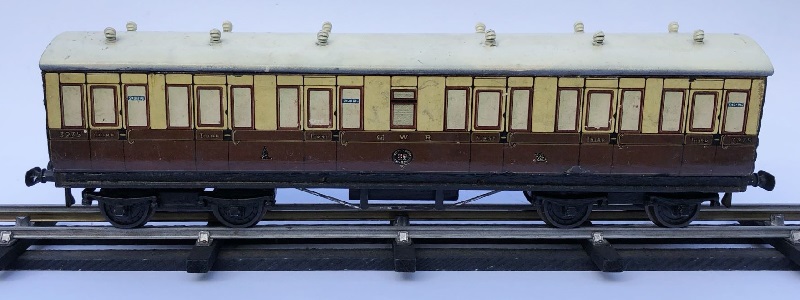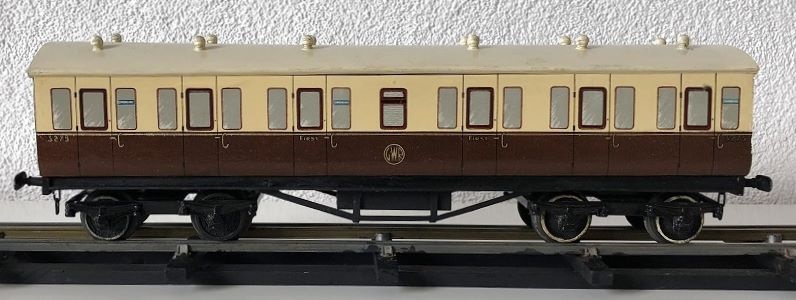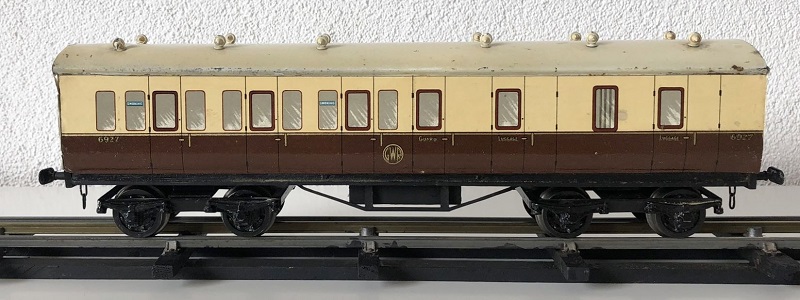1921-1929: 1st series Scale Models, wooden bodies with lithographed sides.
CO/106: N.E.R. 1st-3d Composite Coach, running No. 840, 1921-29.
Solebar lithos only appeared on early production models.
CO/107: N.E.R. Full Brake Van, running No. 106, 1921-29.
CO/120: L. & N.W.R. 1st-3d Composite Coach, running No. 2307, 1921-29.
CO/121: L. & N.W.R. Full Brake Van, running No. 5410, 1921-26/27.
CO/136: M.R. 1st-3rd Composite Coach, running No. 578, 1921-26/27.
CO/137: M.R. Full Brake Van, running No. 159, 1921-26/27.
CO/136: L.M.S. 1st-3rd Composite Coach, running No. 578, 1929.
The litho was originally a Midland version, but overprinted with LMS. With this coach, in the past one owner has scratched away the new panelling, partly revealing the Midland text.
CO/135: L.M.S. 3rd Brake Composite, running No. 358, 1929.
Copies of Leeds Model Company locomotives and rolling stock date from the 1930's when the Japanese Company Seki (or Sakai), supplied the UK market with a range of products under the name 'Stronlite'. Amongst these were a set of printed tinplate copies of the LMS coaches shown above. The locomotive in this Stronlite passenger train set is a copy of a Milbro 4-4-2 Tank locomotive (Pete Gasowski Photo).
1927-1939: 2nd series Scale Models, wooden bodies with lithographed sides.
CO/106: L.N.E.R. Corridor Coach, running No. 2253, 1929-38/39.
This coach and the coach below are late versions with the super detail 'Newalloy' bogies (catalogue code CO/17).
CO/107: L.N.E.R. Corridor Brake Composite, running No. 3627, 1929-38/39.
CO/108: L.N.E.R. Suburban Coach, running No. 38295, 1929-38/39.
CO/109: L.N.E.R. Suburban Brake Composite, running No. 38364, 1929-38/39.
Stronlite tinprinted copy of the L.N.E.R. Suburban Brake Composite, running No. 3827 (Hans van Dissel Collection).
CO/134: L.M.S. Saloon Coach, running No. 18572, 1929-38/39.
This coach and the coach below are late versions with the super detail 'Newalloy' bogies (catalogue code CO/17).
CO/135: L.M.S. Saloon Brake Composite, running No. 18503, 1929-38/39.
CO/138: G.W.R. Corridor Coach, running No. 3275, 1927-32.
Great Western panelled lithos were amongst the first produced post-grouping liveries. These had a short life, because of loss of the lithos in the 1932 fire at the Jack Lane factory. They were replaced by the button type lithos shown below.
CO/138: G.W.R. Corridor Coach, running No. 3275, 1935-38/39.
CO/139: G.W.R. Corridor Brake, running No. 6927, 1927-32.
CO/139: G.W.R. Corridor Brake, running No. 6927, 1935-38/39.
CO/140: G.W.R. Suburban Coach, running No. 3275, 1927-32 (Barend Westerveld collection).

CO/140: G.W.R. Suburban Coach, running No. 3275, 1935-38/39.

CM/141: G.W.R. Suburban Brake Composite, running No. 6927, 1927-32.
NEW ADDITION

CO/141: G.W.R. Suburban Brake Composite, running No. 6927, 1935-38/39.

CO/149: S.R. Corridor Coach, running No. 4526, 1927-36.
CO/143: S.R. Corridor Brake Composite, running No. 2127, 1927-36.
CO/144: S.R. Suburban Coach, running No. 4526, 1927-36.
CO/145: S.R. Suburban Brake Composite, running No. 2127, 1927-36.
CO/152: L.N.E.R. Triple Coach Articulated Train, running No. 6021N, 6022N and 6023N, 1925-32.
CO/150: L.N.E.R. Twin Coach Articulated Train, running No. 6021N and 6023N, 1925-32 (Hans van Dissel Collection).
This is an early model with solebar lithos and hook-type couplings.
CO/156: Pullman Car "HAZEL", 1st class, 1932-38/39.
1948-1949: Rigid Litho Scale Models.
CO/200: L.M.S. Suburban Coach, running No. 3395, Rigid Litho rolling stock 1948-49.
The basis of these coaches was an one piece litho printed card, which formed the body sides and the roof. The card was folded to form the coach profile and fitted between die cast ends on a timber floor.
1937-1959: Bakelite True Scale Models.
CM/50: L.M.S. 1st-3rd Class Vestibule Carriage, running No. 9060, True Scale Bakelite Coach 1937-38/39.
The pre-war versions were made in self-coloured bakelite. After the war all coach bodies were black and the livery was painted on.
CM/51: L.M.S. 3rd Class Vestibule Brake Composite, running No. 6140, True Scale Bakelite Coach 1937-38/39.
CM/52: L.N.E.R. 3rd Class Vestibule Carriage, running No. 7203, True Scale Bakelite Coach 1937-38/39.
The simulated teak finish, produced by mixing Bakelite powders of different colours, made each coach unique in appearance. These coaches could not be offered after 1940. Painting black mouldings to achieve an effective "teak" finish was deemed impossible.
CM/53: L.N.E.R. 3rd Class Vestibule Brake Composite, running No. 4494, True Scale Bakelite Coach 1937-38/39.
CM/52: B.R. Saloon Coach, running No. E18082, True Scale Bakelite Coach 1951-59.
These coaches were always supplied minus the window frets. Mouldings in which all the frets had not fully moulded would have all the remaining frets broken out and diverted for use as BR or SR coaches.
CM/53: B.R. Saloon Brake, running No. E16520, True Scale Bakelite Coach 1951-59.
CM/54: G.W.R. Saloon Coach, running No. 4585, True Scale Bakelite Coach 1948-59.
Towards the end of the company life almost anything was done with the livery of the coaches, including despatch of any coach livery without window frets. Nominally and correctly the GWR roof colour was white. The later models were sent out with black roofs.
CM/55: G.W.R. Saloon Brake, running No. 3438, True Scale Bakelite Coach 1948-59.
CM/56: S.R. 3rd Class Saloon Coach, running No. 1508, True Scale Bakelite Coach 1948-59.
CM/57: S.R. 3rd Class Brake Composite Coach, running No. 1652, True Scale Bakelite Coach 1948-59.